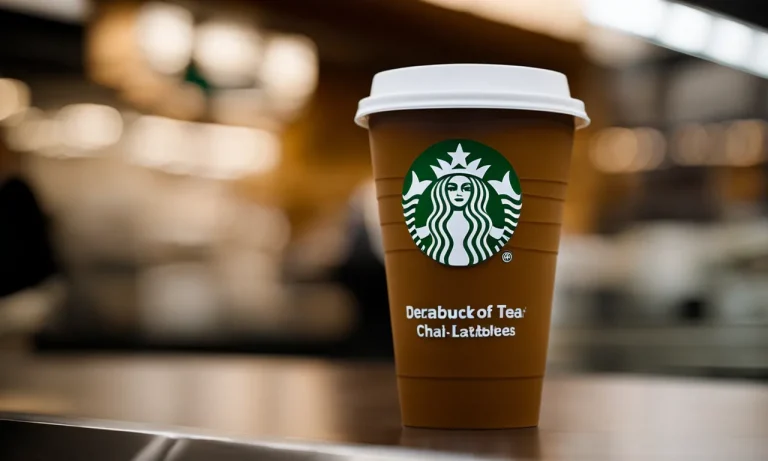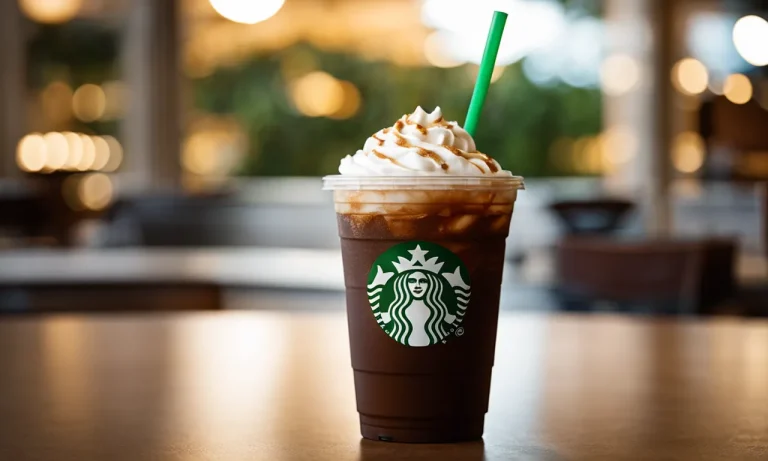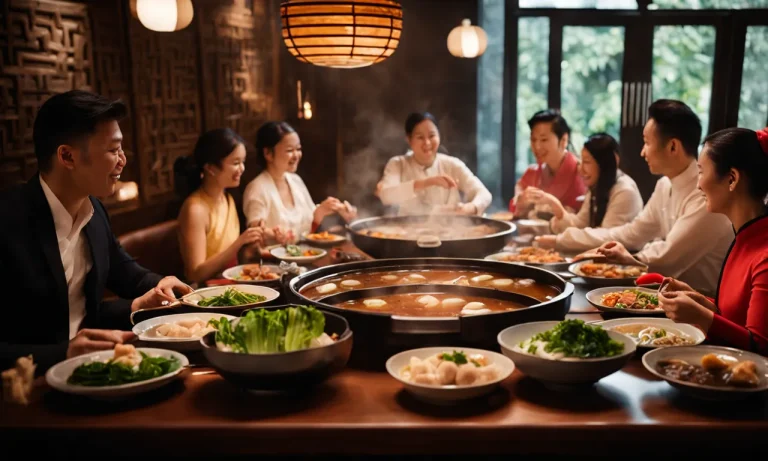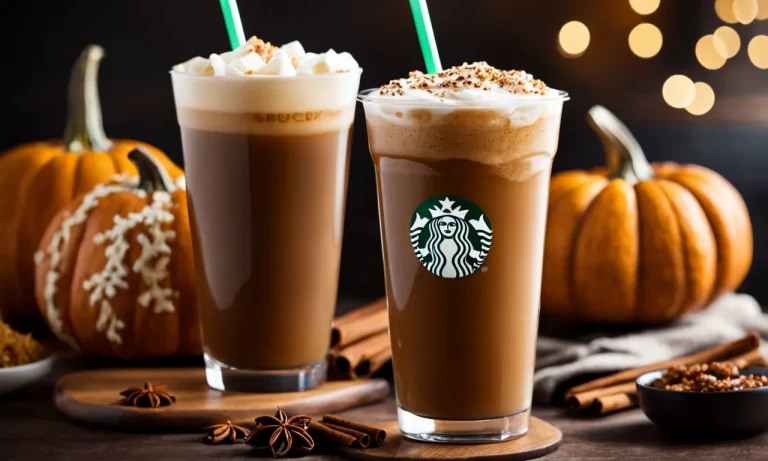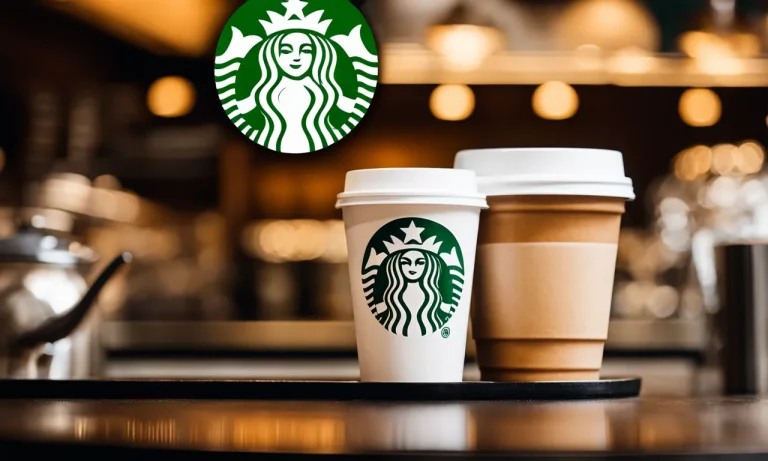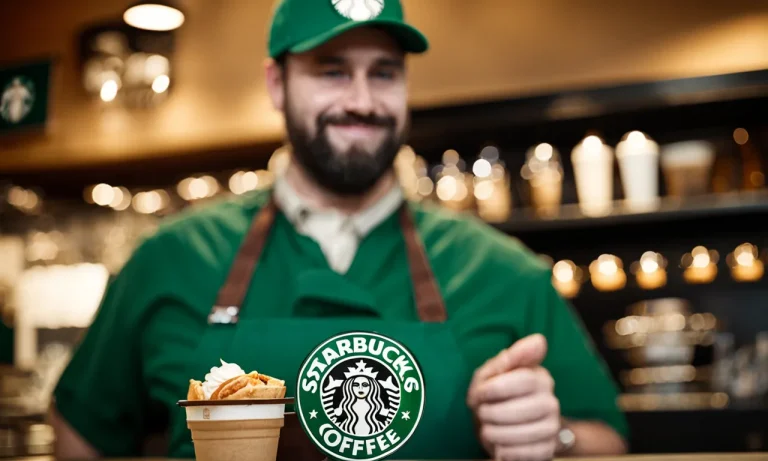With its refreshing fruity flavors, Starbucks Refreshers have become a popular drink choice for many customers. But how does the caffeine content in Refreshers compare to traditional coffee drinks? If you’re trying to limit your caffeine intake or just want to know what to expect from your Starbucks order, read on as we dive into a detailed comparison of caffeine levels in Starbucks Refreshers vs coffee.
If you’re short on time, here’s a quick answer: Most Starbucks Refreshers have 70-90 mg of caffeine per 16 oz serving, while a 16 oz Pike Place Roast coffee has 310 mg of caffeine. So coffee at Starbucks generally has 3-4 times more caffeine than Refreshers.
Caffeine in Starbucks Refreshers
Starbucks Refreshers are popular non-coffee beverages that provide a refreshing and energizing option for those looking to satisfy their caffeine cravings. While they may not contain as much caffeine as Starbucks’ coffee options, they still offer a pick-me-up for those in need.
Let’s take a closer look at the caffeine content in some of the most popular Starbucks Refreshers.
Very Berry Hibiscus Refresher
The Very Berry Hibiscus Refresher is a delightful blend of tangy blackberries, hibiscus flavors, and a touch of sweetness. It offers a burst of fruity flavors without the strong taste of coffee. This refreshing beverage contains about 45-55 milligrams of caffeine per serving.
Although this is less caffeine compared to a cup of coffee, it can still provide a mild boost of energy to help you get through your day.
Strawberry Acai Refresher
The Strawberry Acai Refresher is another popular choice among Starbucks enthusiasts. It combines the sweetness of strawberries and the tartness of acai berries for a delicious and invigorating drink. Similar to the Very Berry Hibiscus Refresher, the Strawberry Acai Refresher contains approximately 45-55 milligrams of caffeine per serving.
It’s a great option for those who prefer a fruity and caffeine-infused beverage.
Dragon Drink
The Dragon Drink is a tropical-inspired refresher that features the flavors of sweet mango and dragonfruit, blended with creamy coconut milk. This vibrant and refreshing beverage contains less caffeine compared to the previous two options. It offers around 35-45 milligrams of caffeine per serving.
If you’re looking for a lighter caffeine boost with a tropical twist, the Dragon Drink is worth a try.
Mango Dragonfruit Refresher
The Mango Dragonfruit Refresher is a popular choice for its tropical flavors and eye-catching pink color. It combines the sweetness of ripe mangoes and the exotic taste of dragonfruit to create a refreshing and tangy drink.
This particular refresher contains approximately 45-55 milligrams of caffeine per serving, providing a similar caffeine kick to the Very Berry Hibiscus and Strawberry Acai Refreshers.
It’s important to note that the caffeine content in Starbucks Refreshers may vary slightly depending on factors such as the size of the drink and any customizations you make. If you’re sensitive to caffeine or looking for a caffeine-free option, Starbucks also offers a variety of decaffeinated and herbal tea options to choose from.
For more information on the caffeine content in Starbucks Refreshers and other beverages, you can visit the official Starbucks website at www.starbucks.com/menu/drinks.
Caffeine in Starbucks Coffee Drinks
Caffeine is a natural stimulant found in coffee that can help increase alertness and reduce fatigue. If you’re a coffee lover, you’re probably curious about the caffeine content in Starbucks coffee drinks. Let’s take a closer look at the caffeine levels in some of their popular offerings.
Brewed Coffee
Starbucks offers a variety of brewed coffee options, ranging from mild to bold. The caffeine content in a cup of Starbucks brewed coffee can vary depending on the size and type of coffee. On average, a 8 fl oz (237 mL) cup of Starbucks brewed coffee contains about 180 mg of caffeine.
However, it’s important to note that the caffeine content can be influenced by factors such as the type of beans used and the brewing method.
Espresso Drinks
Espresso drinks are a popular choice for those looking for a quick caffeine boost. The caffeine content in Starbucks espresso drinks can vary depending on the size and number of shots. For example, a single shot of espresso (1 fl oz or 30 mL) typically contains about 75 mg of caffeine.
A tall (12 fl oz or 354 mL) Starbucks Caffe Americano, which contains 2 shots of espresso, has about 150 mg of caffeine. It’s worth mentioning that espresso drinks can be customized with different syrups and milk options, which can affect the overall caffeine content.
Frappuccinos
Frappuccinos are a popular frozen blended beverage option at Starbucks. While they offer a refreshing taste, they typically contain less caffeine compared to brewed coffee or espresso drinks. On average, a tall (12 fl oz or 354 mL) Starbucks Frappuccino contains about 70 mg of caffeine.
However, it’s important to note that certain Frappuccinos, such as the Coffee Frappuccino, may have a higher caffeine content due to the inclusion of coffee as an ingredient.
It’s important to keep in mind that individual tolerance to caffeine can vary, so it’s always a good idea to be mindful of your own caffeine intake. If you’re sensitive to caffeine or looking for a decaffeinated option, Starbucks also offers a wide range of decaf coffee and tea options.
For more information on the caffeine content in Starbucks coffee drinks, you can visit the Starbucks official website where they provide detailed nutritional information for their beverages.
Comparing Caffeine: Refreshers vs Coffee
Refreshers Have Much Less Caffeine than Brewed Coffee
When it comes to caffeine content, Starbucks Refreshers are significantly lower in caffeine compared to brewed coffee. Refreshers are made with a blend of fruit juice, green coffee extract, and other natural flavors, giving them a refreshing and fruity taste.
However, the amount of caffeine in Refreshers is relatively low, with most flavors containing around 45-55 milligrams of caffeine per serving. This makes Refreshers a great choice for those who want a light and refreshing beverage without the jolt of caffeine found in coffee.
But More Caffeine than Some Espresso Drinks
While Refreshers may have less caffeine than brewed coffee, they still contain more caffeine than certain espresso drinks. Espresso shots are known for their high caffeine content, with a single shot typically containing around 63 milligrams of caffeine.
However, some espresso-based beverages like lattes and cappuccinos are diluted with milk, reducing the overall caffeine concentration. In comparison, Refreshers can provide a moderate caffeine boost while offering a different flavor profile compared to traditional coffee or espresso drinks.
Frappuccinos Vary in Caffeine Content
Frappuccinos, Starbucks’ famous blended coffee beverages, come in a variety of flavors and caffeine levels. While some Frappuccinos, like the Coffee Frappuccino, contain a similar amount of caffeine as a regular brewed coffee, others, like the Vanilla Bean Frappuccino, are caffeine-free.
It’s important to note that the caffeine content in Frappuccinos can vary depending on the size and specific ingredients used. If you’re looking for a caffeine boost, it’s best to opt for a Frappuccino made with coffee or espresso.
According to a study conducted by Caffeine Informer, a website that provides information on caffeine content in various beverages, the caffeine content in Starbucks Refreshers falls within the range of other popular energy drinks like Red Bull and Monster.
However, it’s essential to remember that caffeine affects individuals differently, and moderation is key when consuming caffeinated beverages.
Factors That Impact Caffeine Levels
When comparing the caffeine levels in Starbucks Refreshers and coffee, there are several factors that come into play. These factors can significantly affect the amount of caffeine you consume and the overall impact it has on your body. Let’s take a closer look at some of these factors:
Cup Size
The size of your cup plays a crucial role in determining the amount of caffeine you’ll get from your beverage. In general, larger cup sizes contain more caffeine compared to smaller sizes. For example, a venti-sized Starbucks Refresher has more caffeine than a tall-sized one.
Similarly, a venti-sized coffee will have more caffeine than a tall-sized one. So, if you’re looking for a stronger caffeine kick, opting for a larger cup size might be the way to go.
Customizations like Extra Shots
Customizing your Starbucks beverage with extra shots of espresso or other caffeine boosters can significantly increase the caffeine content. Adding an extra shot of espresso to your coffee or Refreshers can provide that extra jolt of energy you need.
Keep in mind that the caffeine content will vary depending on the type and size of the extra shot you choose.
Type of Coffee Roast
The type of coffee roast used in your beverage can also affect its caffeine levels. Generally, darker roasts have less caffeine compared to lighter roasts. This is because the roasting process breaks down the caffeine molecules, resulting in a lower caffeine content.
So, if you’re specifically looking for a higher caffeine content, opting for a lighter roast coffee or Refreshers might be a better choice.
It’s important to note that these factors can vary depending on the specific Starbucks beverage you choose. To get accurate and up-to-date information on the caffeine content of different Starbucks beverages, it’s always a good idea to check Starbucks’ official website or consult with a barista at your local Starbucks store.
Health Effects of Caffeine
Caffeine is a naturally occurring stimulant that is found in various food and beverages, including coffee and Starbucks Refreshers. While many people enjoy the energizing effects of caffeine, it is important to be aware of its potential health effects.
This section will discuss the recommended daily limits of caffeine, the side effects of consuming too much caffeine, and who should limit their caffeine intake.
Recommended Daily Limits
According to the U.S. Food and Drug Administration (FDA), most healthy adults can safely consume up to 400 milligrams of caffeine per day. This is equivalent to about four cups of coffee or two Starbucks Refreshers.
However, it’s important to note that individual sensitivities to caffeine can vary, so it’s best to listen to your body and adjust your intake accordingly.
Side Effects of Too Much Caffeine
Consuming too much caffeine can lead to a range of side effects. In the short term, it can cause restlessness, increased heart rate, and difficulty sleeping. Additionally, excessive caffeine intake can lead to dehydration, as it is a diuretic that increases urine production.
In rare cases, consuming extremely high doses of caffeine can even result in caffeine overdose, which can cause symptoms such as nausea, vomiting, and irregular heartbeat.
Who Should Limit Caffeine Intake
While caffeine is generally considered safe for most people, there are certain groups who should limit their intake. Pregnant women are advised to consume no more than 200 milligrams of caffeine per day, as higher amounts have been linked to an increased risk of miscarriage and preterm birth.
Individuals with certain medical conditions, such as heart problems or anxiety disorders, may also be advised to limit their caffeine intake. It’s always a good idea to consult with a healthcare professional if you have any concerns about your caffeine consumption.
Conclusion
When comparing Starbucks Refreshers vs coffee, coffee drinks generally contain significantly more caffeine. A 16 oz cup of Pike Place Roast has around 3-4 times the amount of caffeine as a Similar-sized Refresher.
However, factors like cup size and customizations can impact caffeine levels in both types of drinks.
Understanding the caffeine content in Starbucks Refreshers and coffee can help you make the best choice for your caffeine needs. But keep in mind that health experts recommend limiting your daily caffeine intake to 400mg or less.
Overall, Refreshers can provide a lower caffeine option while still giving you bright fruit flavors to refresh your day.

